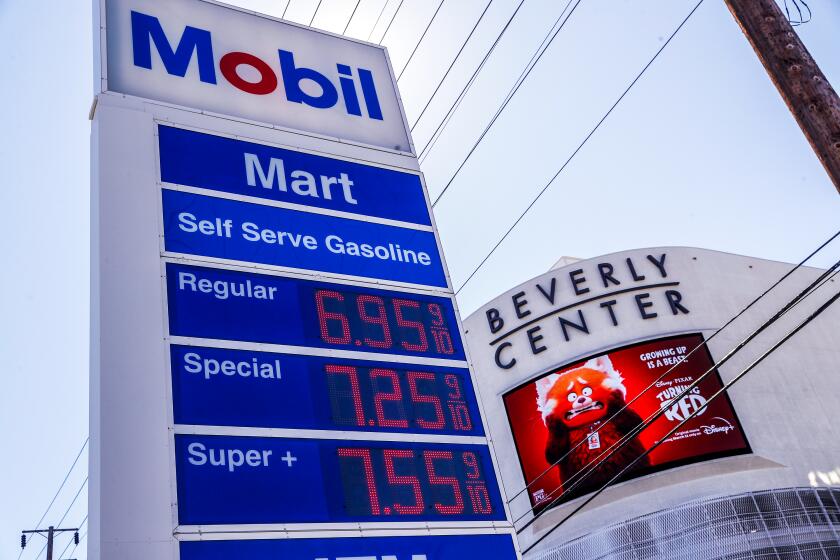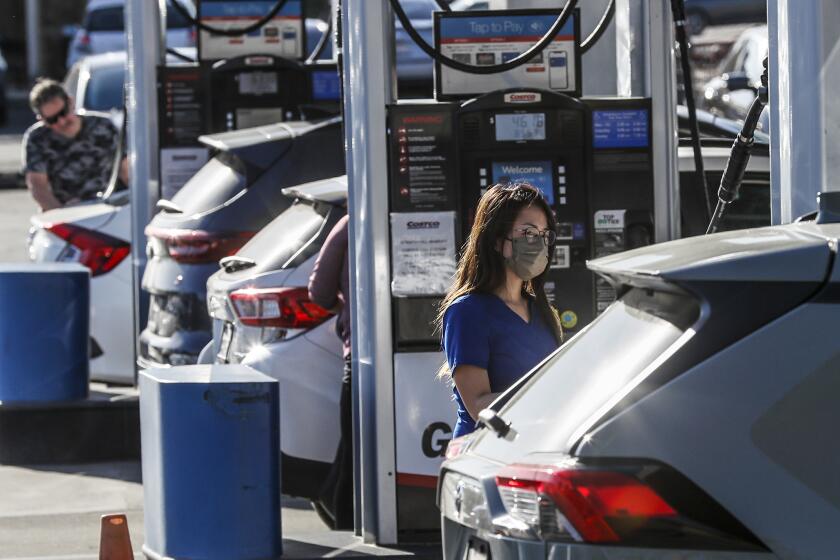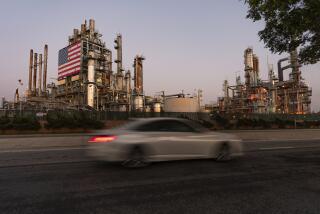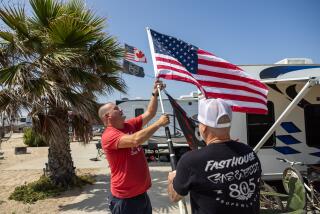Think U.S. gas prices are high? Try filling up in Hong Kong — for around $11 a gallon
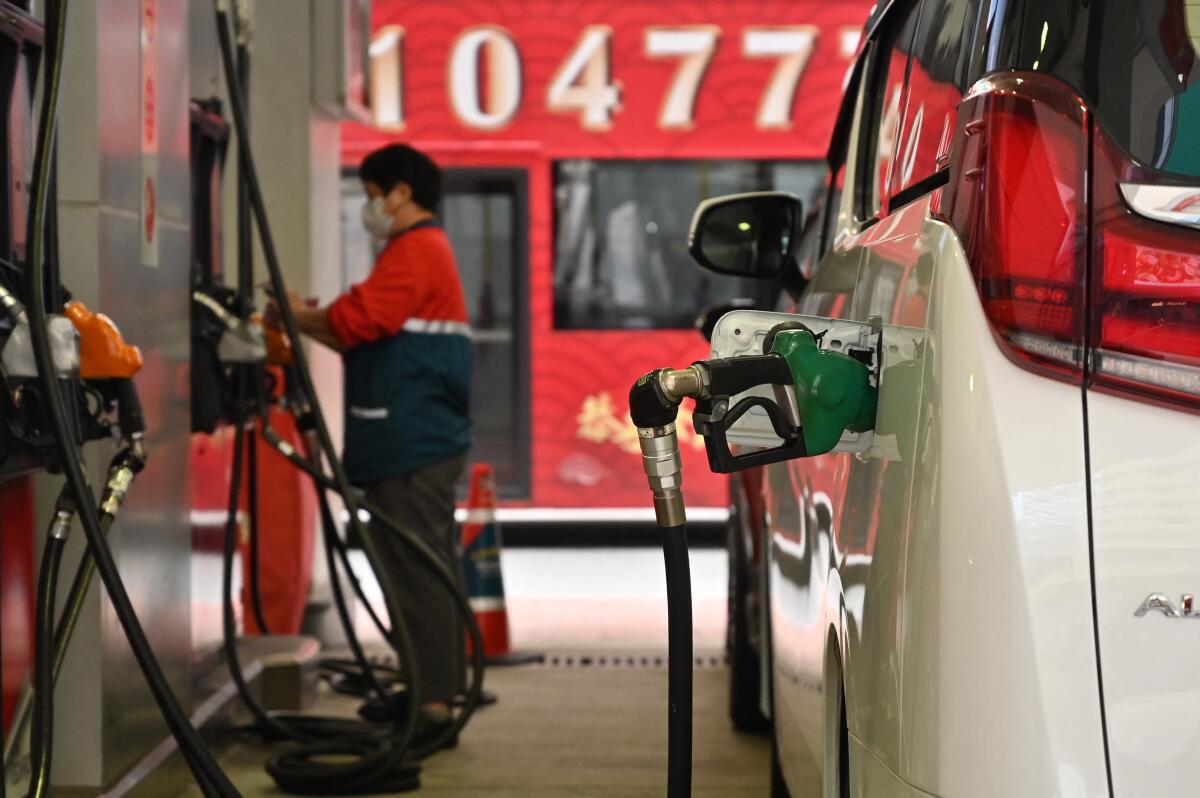
- Share via
SINGAPORE — There’s no debate, the $5.83 Californians are paying on average for a gallon of gas stings. But how would you feel if you were charged $10.90 a gallon?
That’s what Stimson Ho is confronted with when he pulls up to his usual Esso station in Hong Kong’s Kowloon neighborhood. Filling up his compact SUV will set him back $120. Prices have been so high in the Asian financial center that Ho no longer drives his car to work, opting instead to ride the hard aluminum seats on the city’s subway trains.
“It’s so expensive in Hong Kong,” said Ho, a 58-year-old government contract worker, “but in America, the price is so cheap.”
Ho proves, like most things in life, prices at the pump are all relative.
Even before Russia’s invasion of Ukraine roiled energy markets, Hong Kong, a semiautonomous city in southern China, was one of the most expensive places in the world to fill up a tank.
The same goes for Singapore, another financial hub in Asia, and a host of Western European nations such as the Netherlands, Norway, Finland, Denmark, Sweden, France and Britain — all countries where gas costs more than $8 a gallon.
The United States, by comparison, is still the most affordable advanced nation to purchase gas in, on par with the likes of developing countries such as Liberia, Rwanda, El Salvador and Zambia, according to research site GlobalPetrolPrices.com.
“The U.S. actually has some of the cheapest gasoline in the world,” said Rob Smith, director of global fuel retail at S&P Global. “Even California was, until the recent price spike, below or even with most other major markets.”
It certainly doesn’t feel that way for motorists in California, some of whom are crossing the border to Mexico to save a few dozen cents a gallon. The infamous Mobil station at La Cienega and Beverly boulevards is still hovering at $7 a gallon for regular gas. The statewide price surge prompted Gov. Gavin Newsom to unveil a plan to send $400 to Californians for each registered vehicle.
You’ve seen the signs advertising $6.95, $6.99 or even $7.05 for a gallon of regular unleaded. But who’s buying it, and why?
What keeps prices down in the U.S. compared with other wealthy nations? For one, the U.S. is the world’s top producer of oil, ensuring a steady domestic supply. But more important, fuel taxes are among the lowest of any major nation.
American consumers were paying 18 cents per gallon in federal taxes and an average of 31 cents per gallon on state taxes as of Jan. 1, according to the latest data from the U.S. Energy Information Administration. Those rates have fallen since as some states have moved to curb the pain on consumers by suspending gas taxes.
Other countries are looking at ways to cut costs for motorists, but traditionally Europe has levied much steeper taxes on its drivers. Fuel taxes exceed $3 a gallon in the United Kingdom, the Netherlands, Turkey and Israel, and top $2 a gallon in Germany, France, Belgium and Denmark, according to the U.S. Department of Energy.
Although the low taxes in the U.S. are welcomed by consumers, it also makes prices more volatile and vulnerable to market shocks like those experienced this year. The main gauges for global spot prices, Brent crude oil and West Texas Intermediate, soared by more than 60% since the start of the year. Both benchmarks have since cooled by about 15% after members of the International Energy Agency agreed to join the U.S. in releasing more oil reserves.
“The difference is taxes,” Smith said. “In the U.S., the spot price accounts for a far larger chunk of the retail price, which means that U.S. retail prices rise and fall far more on a percentage basis than it does in other markets. So prices in the U.S. are up 50% from a year ago but by less than 30% in Europe.”
Persistently high taxes in Europe mean consumers there aren’t feeling the shock that Americans are. Those taxes are partly designed to promote environmental policies by discouraging excess driving and making it costly to purchase gas-guzzling vehicles — something tax reform advocates in the U.S. have called for.
Of course, no country is more dependent on automobiles than the U.S., with its sprawling suburbs, uneven public transportation network and vast highway system. Americans drive an average of 13,476 miles a year, well above the second-highest country, Canada, where motorists average 9,445 miles a year.
Newsom’s $11-billion proposal is designed to offset the rising prices consumers are paying at the pump and also includes savings for those who rely on public transportation.
All that mileage means consumers in the U.S. are spending a larger share of their income on gas than consumers elsewhere — putting lower American fuel costs in a different perspective.
The average U.S. driver spends 2.16% of their salary at the gas pump, according to Bloomberg data. That’s compared with 1.08% in the United Kingdom, 0.59% in France and 0.52% in Hong Kong, where distances are much shorter.
Then there are unique situations like Singapore, where 0.55% of an average driver’s salary goes to gas, but the cost of owning a vehicle is prohibitively high. To limit the number of vehicles on the road, the government requires motorists to bid for a “certificate of entitlement,” a license that can cost more than $70,000 and must be renewed after 10 years. Add vehicle taxes to the equation and a plain Honda Civic can cost triple what it costs in the U.S.
“There’s a high entry cost just for the right to have a car in Singapore,” said David Broadstock, a senior research fellow with the Energy Studies Institute at the National University of Singapore. “The cost can even exceed the retail value of the vehicle itself. You do not face this in the U.S.”
Average “petrol” prices, as they’re known in the former British colony, stood at a record $8 a gallon Tuesday, increasing one-third from before the COVID-19 pandemic and doubling in 13 years.
Singaporean drivers seized on the reopening of the land border with Malaysia on Friday, which had been shuttered by the pandemic, to restart a time-honored tradition of crossing over to buy cheaper gas. That immediately sparked controversy after Malaysians accused Singaporean motorists of illegally pumping subsidized fuel — called RON95 — reserved for locals.
In a Facebook post Sunday, former Malaysian Prime Minister Najib Razak posted a picture of an alleged violator and complained about the cost to the public.
“RON95 petrol is a controlled item because it is highly subsidized,” said Najib, who is accused of pocketing hundreds of millions of dollars in public funds in the 1MDB scandal. “It is against the government’s Supply Control Act to sell RON95 to foreigners.”
Special correspondent Antonia Tang in Hong Kong contributed to this report.
More to Read
Sign up for Essential California
The most important California stories and recommendations in your inbox every morning.
You may occasionally receive promotional content from the Los Angeles Times.
